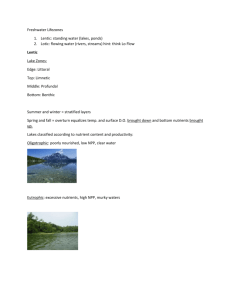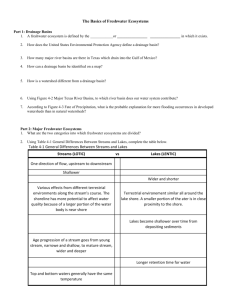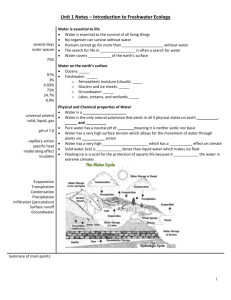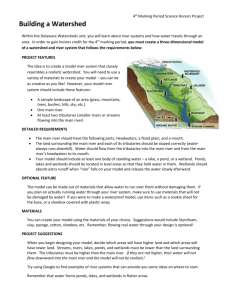Unit 1 Notes – Introduction to Freshwater Ecology
advertisement
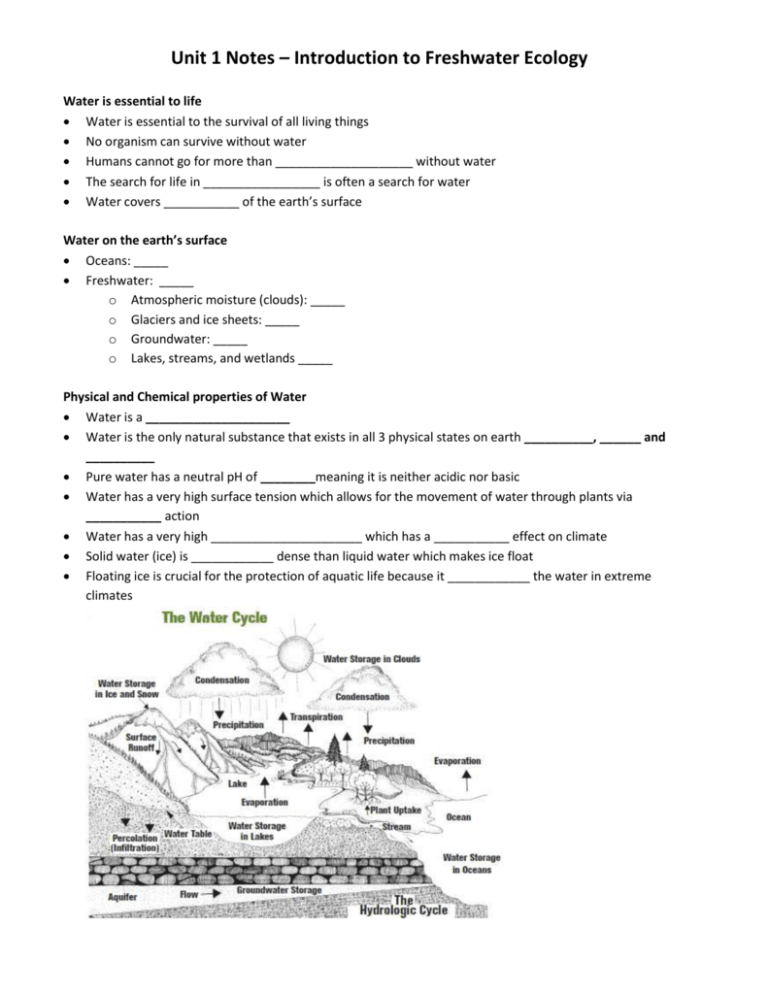
Unit 1 Notes – Introduction to Freshwater Ecology Water is essential to life Water is essential to the survival of all living things No organism can survive without water Humans cannot go for more than ____________________ without water The search for life in _________________ is often a search for water Water covers ___________ of the earth’s surface Water on the earth’s surface Oceans: _____ Freshwater: _____ o Atmospheric moisture (clouds): _____ o Glaciers and ice sheets: _____ o Groundwater: _____ o Lakes, streams, and wetlands _____ Physical and Chemical properties of Water Water is a _____________________ Water is the only natural substance that exists in all 3 physical states on earth __________, ______ and __________ Pure water has a neutral pH of ________meaning it is neither acidic nor basic Water has a very high surface tension which allows for the movement of water through plants via ___________ action Water has a very high ______________________ which has a ___________ effect on climate Solid water (ice) is ____________ dense than liquid water which makes ice float Floating ice is crucial for the protection of aquatic life because it ____________ the water in extreme climates What is a freshwater ecosystem? A freshwater ecosystem has two components: o ___________________(living organisms) o ___________________( the non-living environment in which they inhabit Both the biotic and abiotic elements of the ecosystem must be healthy for it to thrive Why are freshwater ecosystems important? They provide major ______________ and _________________ benefits They are irreplaceable reservoirs of ________________ Ecological benefits Climate ________________ Nutrient ___________ Water treatment Flood control Groundwater _____________ __________ for many species Genetic resources and _______________ Scientific information Economic benefits Food ___________ water ___________ water Hydroelectricity Transportation corridors ______________ Employment Drainage basins Freshwater ecosystems lie within ____________________________ Most drainage basins are river basins Texas has 23 major river basins Waco is in the _________________________, the longest river within Texas Watersheds vs. drainage basins The term “watershed” has a much broader meaning than drainage basin “Drainage basin” refers to the topography that drains water from a geographic are into a single outlet “Watershed” is a broader term that includes the natural habitat and human built environment of the area. Texas Lakes and Rivers Texas has over 10,000 lakes and ponds Only one major lake is natural (Caddo Lake) all others are man-made with dams Texas has over 11,000 streams and rivers large enough to be named 191,000 miles of streams and rivers Only 40,000 miles are perennial (wet year round) Texas has 6.3 million acres of wetlands (that’s a lot!) Water flows in some freshwater systems and stands in others Flowing (______________) systems of freshwater (Streams and rivers) Standing (_____________) bodies of freshwater (lakes, ponds, and inland wetlands) General differences between streams and lakes Streams (lotic) Lakes (lentic) Normally oxygen ____________ Oxygen ___________ at deeper levels Shallower Deeper Streams erode channels making them _________ and wider (canyons) Age progression goes from young narrow and shallow stream to mature wider and deeper stream Top and bottom waters generally the _______ temperature Lakes become _____________ from deposited sediments Age progression goes from lake to marsh or swamp to land May have _________ temperatures from top to bottom Stream types ________________ streams flow year round ________________ streams become dry for a week or longer each year Many of the streams around Waco are intermittent _______________ streams flow only following rainfall and cease to flow shortly after. Gaining and losing streams Streams can gain water from the ground, usually fed by springs or groundwater (__________ stream) Streams can lose water to the ground through percolation (____________ stream) Stream habitat types _________________streams are characterized by fast moving water and little sediment _________________ streams are slow moving, meandering, and deposit sediment Streams can have both ______________ zones and _____________ zones at the same time A _______________ zone is a vegetated buffer between streams and nearby lands. A riparian zone is often heavily wooded. Formation of lentic systems (lakes, ponds, and wetlands) In the northern regions, many lakes and ponds were gouged out by glaciers during the _______ Lakes formed by meanders in rivers flowing over floodplains are called ____________ lakes __________________ lakes are small ephemeral lakes common in West Texas and the southern high plains Wetlands – the transition zone between water and land There are four basic categories of wetlands, _____________ are shallow wetlands originating from water runoff and floodwaters and are mainly grassy ____________ are areas of wet soils with poor drainage and standing water during times of the year. Swamps are dominated by trees and scrubs _____________ are characterized by floating spongy peat deposits. They support carnivorous plants and are acidic ______________ are groundwater fed wetlands that are more alkaline that bogs Lentic habitat zones (lakes and ponds) ____________ zone – shallow vegetated zone near the shoreline _________________ zone – the top layer of open water areas close enough to the surface for light to penetrate and photosynthesis to occur __________________ zone – deep bottom water area with little or no light penetration __________________ zone – the bottom surface of the lake fed only by dead matter that falls from the upper layers Some Lakes Have More Nutrients than Others ______________________ lakes – low levels of nutrients and low primary productivity _____________________ lakes – moderate nutrient levels. _____________________ lakes – High levels of nutrients and high primary productivity ______________________ lakes – excessive nutrient levels with frequent plankton blooms (pond scum) Water stratification in lakes Large deepwater lakes become layered during summer months _______________ – The warmest zone near the water surface _______________ – The middle layer where temperature declines. The Thermocline is found here, where the temperature changes rapidly _______________ – The bottom layer that is deep and cold with little change in temperature Lakes turnover When the seasons change, the water in lakes ______ _____________ During winter when the surface layer becomes colder than the bottom layers the colder more dense water sinks and the lake “turns over” Texas lakes turnover once a year, northern lakes turn over in both spring and fall Aging of lakes Lakes and ponds go through a natural aging process called ________________ As lakes slowly fill with sediment they become marshes, swamps, or bogs As wetland plants move in they build a soil base and eventually the lake becomes dry land

